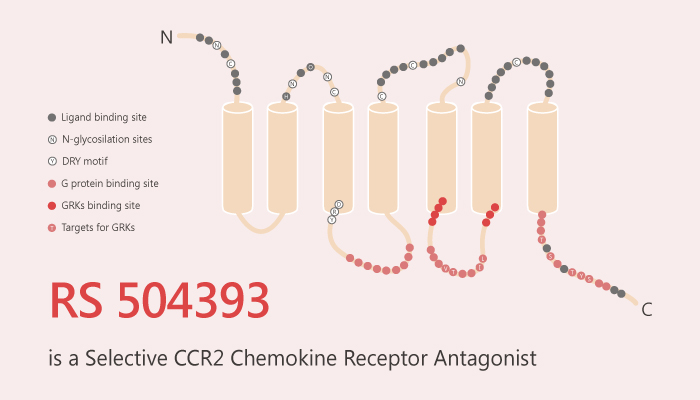Monocyte chemoattracant-1 (MCP-1) stimulates leukocyte chemotaxis to inflammatory sites, such as rheumatoid arthritis, atherosclerosis, and asthma, by use of the MCP-1 receptor, CCR2. CCR2 is also a member of the G-protein-coupled seven-transmembrane receptor superfamily. RS 504393 has been identified as a selective CCR2 chemokine receptor antagonist. RS 504393 exhibits IC50 values of 89 nM and >100 μM for inhibition of human recombinant CCR2 and CCR1 receptors respectively.

In vitro, in A549 cell line, RS504393 treatment significantly inhibited the expression of CCR1, CCR2 and interleukin (IL)-8 after either LPS or tumor necrosis factor- stimulation. Additionally, treatment with RS504393 had a noteworthy preventative effect on LPS-induced over-expression of IL-1, plasminogen activator inhibitor and CCR2.
Furthermore, in vivo, RS504393 (0.3-3 μg) with CCL2 progressively blocked thermal hyperalgesia dose-dependently in mice. Besides, RS 504393 (5 mg/kg, i.v.) supressed the elevated numbers of leukocytes and increased total protein content in BALF induced by The LPS. Likewise, RS504393 significantly down regulated the LPS-induced elevation of IL-1β, PAI-1 mRNA and protein expressions. RS504393 also significantly suppressed induced lung edema, protein-rich fluid, polymorphonuclear accumulation and bronchial wall thickening induced by LPS. In addition, RS-504393 significantly reduced renal pathology, especially the extensive interstitial fibrosis mediated by decrease in type I collagen synthesis in a UUO model.
In summary, RS504393 has potential to treat inflammatory diseases, such as fibrosis and allergy. Further work still need to be carried out.